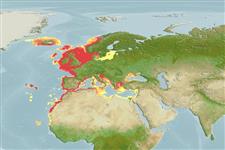Common names from other countries
Classification / Names / Names
Namen | Synonyme | Catalog of Fishes (gen., sp.) | ITIS | CoL | WoRMS
Environment: milieu / climate zone / depth range / distribution range
Ökologie
; tiefenbereich 0 - 400 m (Ref. 78075), usually 15 - 50 m (Ref. 106788). Temperate, preferred 12°C (Ref. 107945); 68°N - 15°N, 32°W - 36°E (Ref. 113881)
Eastern Atlantic and the Mediterranean Sea. Temperate to polar.
Length at first maturity / Size / Gewicht / Alter
Maturity: Lm ? range ? - ? cm Max length : 11.0 cm SHL Männchen/unbestimmt; (Ref. 78075); max. veröff. Alter: 8 Jahre (Ref. 8702)
Max depth range from Ref. 113966. Suspension feeder (Ref. 3477). Found on sand, mud, gravel; also associated with maerl beds and mussel beds (Ref. 114800).
Life cycle and mating behavior
Geschlechtsreife | Fortpflanzung | Ablaichen | Eier | Fecundity | Larven
Members of the class Bivalvia are mostly gonochoric, some are protandric hermaphrodites. Life cycle: Embryos develop into free-swimming trocophore larvae, succeeded by the bivalve veliger, resembling a miniature clam.
Demir, M. 2003. (Ref. 2754)
IUCN Rote Liste Status (Ref. 130435)
CITES Status (Ref. 108899)
Not Evaluated
Not Evaluated
Nutzung durch Menschen
Fischereien: kommerziell
FAO - Aquakultur: production; Fischereien: landings | FishSource | Sea Around Us
Tools
Internet Quellen
Estimates based on models
Preferred temperature
(Ref.
115969): 7 - 15.9, mean 10.1 (based on 520 cells).
Widerstandsfähigkeit
hoch, Verdopplung der Population dauert weniger als 15 Monate. (K=0.51-1.34; tmax=8).
Prior r = 0.56, 95% CL = 0.37 - 0.84, Based on 1 data-limited stock assessment.
Verwundbarkeit
Low vulnerability (22 of 100).
